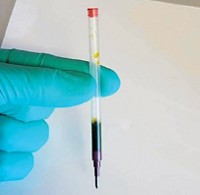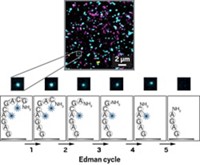Advertisement
Grab your lab coat. Let's get started
Welcome!
Welcome!
Create an account below to get 6 C&EN articles per month, receive newsletters and more - all free.
It seems this is your first time logging in online. Please enter the following information to continue.
As an ACS member you automatically get access to this site. All we need is few more details to create your reading experience.
Not you? Sign in with a different account.
Not you? Sign in with a different account.
ERROR 1
ERROR 1
ERROR 2
ERROR 2
ERROR 2
ERROR 2
ERROR 2
Password and Confirm password must match.
If you have an ACS member number, please enter it here so we can link this account to your membership. (optional)
ERROR 2
ACS values your privacy. By submitting your information, you are gaining access to C&EN and subscribing to our weekly newsletter. We use the information you provide to make your reading experience better, and we will never sell your data to third party members.
Drug Discovery
Peptides encode small molecule libraries
Drug discovery tool stores information in strings of non-canonical amino acids
by Bethany Halford
March 3, 2023

DNA has been used for decades as a convenient chemical for storing information, thanks to its ease of synthesis and decoding. Scientists have used DNA tags to encode information in massive chemical libraries, which has been useful in drug discovery. In these DNA-encoded libraries, or DELs, the DNA holds the directions for making the small molecule to which it is linked. Now chemists at the Massachusetts Institute of Technology are offering another approach to storing information for small molecule libraries—peptides.
These peptide-encoded libraries (PELs) were developed by professors Stephen L. Buchwald and Bradley L. Pentelute along with postdoctoral scholars Simon L. Rössler and Nathalie M. Grob. The PELs offer increased density for information storage because they use 16 non-canonical amino acids as storage units, compared to DNA’s four units. Peptides also boast greater stability than DNA, which can make them easier to use in certain types of chemical synthesis when building the compounds in the library. For example, the chemists say that it’s easier to do palladium-mediated reactions, which are useful for building C–C and C–N bonds, with peptide tags than with DNA tags.
“Nowadays you can do almost any reaction in the presence of DNA,” Rössler says, “just not as well as you would like to.” Using peptides, he says, can lead to higher-quality libraries that feature molecules that are more drug-like.
The MIT researchers used split-and-pool synthesis on polystyrene resins to make a PEL of about 40,000 compounds. With this PEL, they can see which of their peptide-tagged compounds bind to a particular protein, washing away anything that doesn’t bind. Mass spectrometry decodes the peptides attached to the molecules that bound, giving the chemists the instructions for synthesizing the attached small molecules. They then make the molecules without the peptide tag (Science 2023, DOI: 10.1126/science.adf1354).
“I think the practicality and the speed at which we can synthesize is a big advantage in our system,” Grob says.
Rössler agrees. “We can literally go from running a screen to having a resynthesized small molecule within less than a week,” he says.
Mike Waring, a professor of medicinal chemistry at Newcastle University, says using a non-DNA-based method of encoding information is interesting. Sequencing using mass spectrometry should be applicable to other encoding tags, he says.
Waring points out some disadvantages: unlike with DNA, there’s no amplification of the encoded sequences, so decoding relies on the sensitivity of the mass spectrometry. Also, he says that the peptide could bind to the protein target.
The MIT team has applied for a patent on the technology and has had interest from several pharmaceutical companies. Rössler says that peptides hold promise as an information storage medium in other areas where DNA has been used previously—particularly if that information is intended to last for a long time. After all, scientists have found peptides remain in dinosaur bones long after DNA has decomposed.





Join the conversation
Contact the reporter
Submit a Letter to the Editor for publication
Engage with us on Twitter